Devialet Silver Phantom Review
Devialet is currently one of the hottest companies in the audio industry. With the Devialet Silver Phantom, they want to reinvent the loudspeaker filing about a hundred patents. We had a test unit for four days and here is our review.
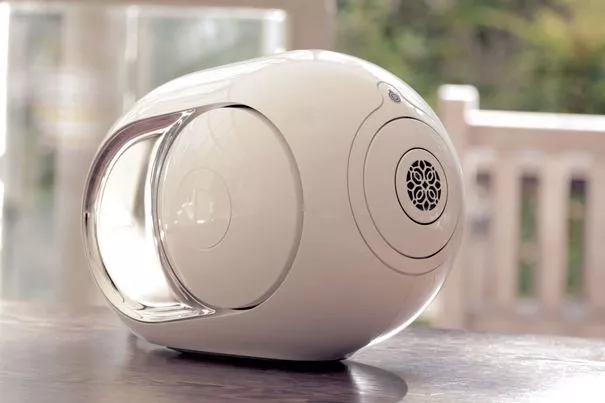
The Paris-based company Devialet wants to mix up the sometimes somewhat conservative audio industry with a concentrated load of innovations.
The Devialet Silver Phantom promises no less than the revolution in high-end HiFi. The WLAN loudspeaker, which is only the size of a head, is entered for the test.
These Devialet Silver Phantom amplifiers already shone with new technologies, compact dimensions and a sound that made many an expensive product blush. Now the Devialet Phantom is causing a sensation and could make the Parisian company known to a wide audience very quickly.
Devialet Silver Phantom Pros And Cons
Pros
- chic, extraordinary design
- high technical standard
- high flexibility regarding possible music sources and application area
- Easy management through the app.
- Bass reproduction
- Software to handle it
- Dynamic sound
- Potency
- Also NAS (network-attached storage) available (2020 update)
Cons
- Design that needs getting used to.
- high price
- Gets warm easily
Devialet Silver Phantom At A Glance
With the Phantom and its stronger brother Silver Phantom, the French manufacturer introduces its first own loudspeaker and promises the finest HiFi sound, as it otherwise only sounds from man-high floor-standing loudspeakers. Is the Phantom a serious competitor for a space-consuming, classic HiFi system?

Devialet sells the 750 watt Phantom for a full 1,690 and the 3,000 watts, otherwise identical Silver Phantom for 1,990 dollars each. It receives music via Bluetooth, WLAN, LAN or via optical digital input by means of a player.
Lots of Watts available. See how to make a matching between an amplifier and speakers in this complete article. There you will understand the importance of Watts and Ohms.
If you want to operate two Phantoms as a stereo ensemble or in different rooms as a multi-room system, you also need the audio router called Dialog for 299 euros. The small white box complements the Phantom with online music services, brings a USB, and a further optical digital connection with it and gets along on Powerline without an additional adapter – so it also receives music directly from the wall socket. You connect it to the home router, and it distributes the music via WLAN to the Devialet Silver Phantom.
With the Devialet Silver Phantom, the Parisian high-tech company wants to revolutionize nothing other than loudspeaker reproduction. Ten years of development and an incredible 77 new patents have gone into the product.
Most patents concern mathematical algorithms and applied techniques to control the behavior of the loudspeaker in interaction with the electronics.
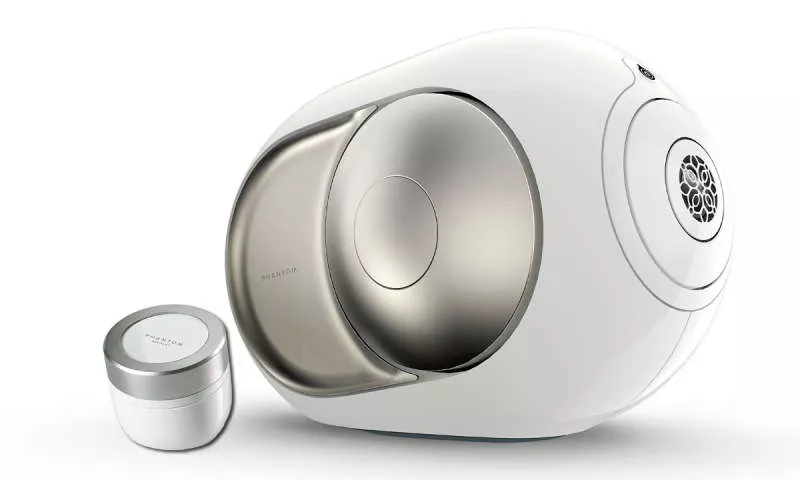
Can a loudspeaker that is so clearly trimmed to design also sound good? Yes, it can. Estee Lauder? No, what looks like a cream jar is actually the 149 dollars remote control to the Phantom.
A conventional loudspeaker is essentially a very faulty converter of electrical energy into sound. During the conversion, high levels of distortion occur, which falsify the original music signal. Devialet wants to change this with innovations.
With the free app called Spark, the Devialet Silver Phantom not only plays music stored on their smartphone but also music from online music services. Qobus, Tidal, and Deezer are among them: the two most important services Apple Music and Spotify are now present (update 2020) too, using Bluetooth connection.
With the clearly arranged Spark app, which is only available in English, the system can be set up and managed in no time at all. Thanks to meaningful graphics, this also works without any knowledge of English. A feature that is necessary for many countries.
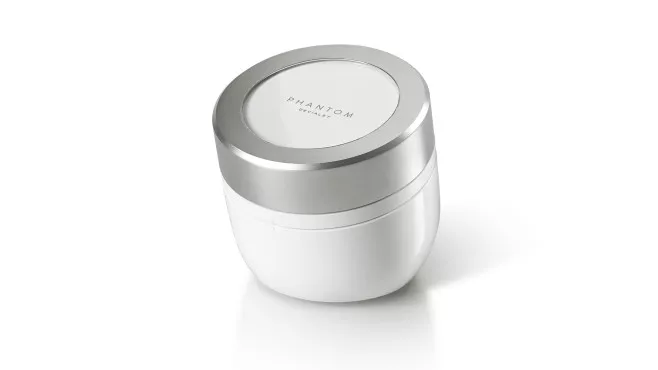
No cream jar: This fancy remote controls no more than the volume. Cost: 200 dollars. Devialet Phantom Remote Control © Devialet
Devialet Silver Phantom Secret Is The Bass Range
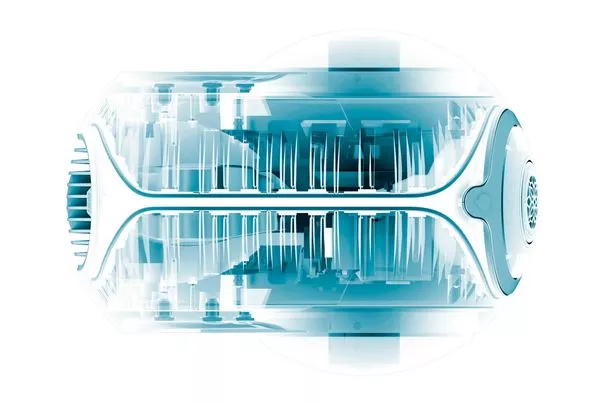
THE SKELETON OF THE PHANTOM
At high volumes, in particular, most people have probably already heard the unwanted “background noise” from loudspeakers. Very few loudspeakers are really “party-proof”, or if they are, then only loudspeakers with good efficiency but a reduced bass range. In the living area, however, one usually prefers small loudspeakers that nevertheless reproduce the full extent of the music information. However, the bass range of a spring-mass system – like conventional dynamic loudspeakers – physically requires cabinet volume.
A conflict quickly arises between the desire for a small loudspeaker that does not dominate the living ambiance and a low-frequency reproduction in which not one or two octaves of music information fall by the wayside.
What many manufacturers neglect: An extended bass range makes it possible to hear pleasantly quietly and still perceive the full musical information. If a loudspeaker conceals the deepest bass components, the user tends almost automatically to increase the volume in order to compensate for the missing sound foundation.
If a loudspeaker conceals the deepest bass components, the user tends almost automatically to increase the volume in order to compensate for the missing sound foundation
Devialet decided to overcome the limitations of conventional loudspeakers in the bass range with the Devialet Silver Phantom by using extensive digital signal control. A very ambitious undertaking.
Twenty engineers alone worked permanently on the development of electronics and software solutions. Specialists from the automotive industry designed a completely new housing that can withstand extreme pressures, such as those required for injection pumps.
Only in this way was it possible to achieve such deep bass reproduction from the only 1.58 galloons (six liters) of cabinet volume that one would otherwise only find in loudspeakers with at least twenty times more voluminous cabinets.
Devialet specifies 16 Hertz as the lower limit frequency. The measurements showed 25 Hertz for minus three decibels. Still an incredible value for a loudspeaker with such a small volume.
Sound Machine
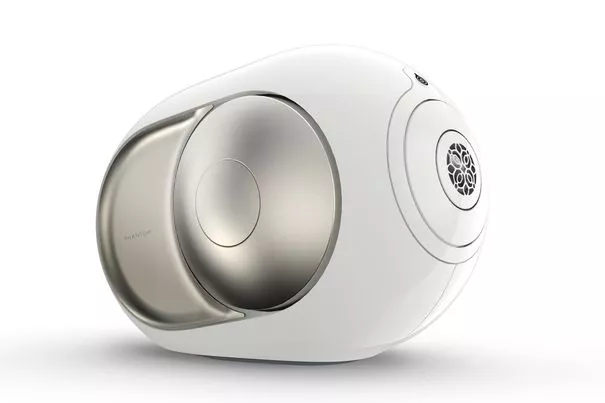
To call the Devialet Silver Phantom a loudspeaker is actually a gross understatement. Rather it is a complete sound system with all modern ingredients. It is controlled via the network, be it via cable or WLAN. If you want it to be fast and practical, it also connects to a smartphone or tablet via Bluetooth.
You do not need more than one source on which the Spark management software can be installed: it is available for all common operating systems. A tablet or smartphone is ideal for operation. The Phantom itself only has a Power On/Off switch.
A super chic addition is the wireless volume control, which is available as an accessory and fits perfectly in your hand. The electronics of the amplifier part are already housed in the extremely compact Phantom. Speaker cables or equipment towers, forget it, all history with the Phantom.
The Devialet Silver Phantom is available in two versions, which only differ in the amplifier power and the maximum achievable volume. With the 3000 Watt amplifier, the Phantom silver can also sound a larger loft without any problems, while for most living rooms the 750 Watt standard Phantom is absolutely sufficient.
The music itself must be stored on a computer or tablet available on the network. Network storage (NAS) with its own music server is now supported (update 2020).
Apart from Apple Music, all well-known music services such as Spotify or Deezer are supported. Tidal and Qobuz are certainly recommended for a product in the quality of the Phantom. Both offer music uncompressed in CD quality and partly even in Hi-Res. A three-month free trial subscription to Tidal is included with the purchase of the Phantom.
If you still want to connect a CD player or play the TV sound via the Phantom, you can do so via the digital input. Analog inputs were omitted immediately. Similar to Apple, you concentrate on modern applications and sometimes cut down on the traditional.
Devialet has also thought about multiroom playback. With the Dialog distribution box for an additional 300 dollars, up to 24 Phantoms can be supplied with music individually or in parallel party mode. Somewhat painful is that you already have to purchase the dialog router connected via network cable for stereo mode.
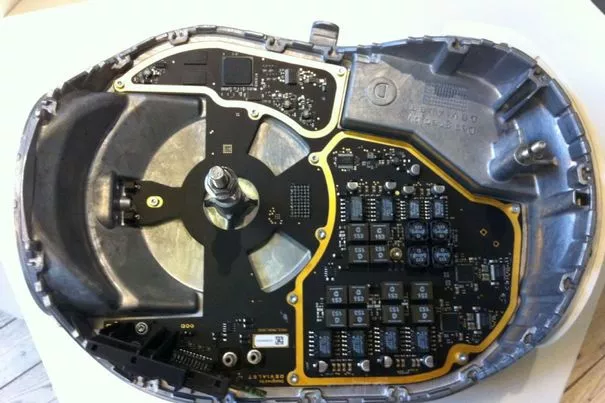
The die-cast chamber for the bass drivers and electronics of the Devialet Phantom
With the ADH (Analog Digital Hybrid) amplifier topology, Devialet combines the advantageous sonic characteristics of Class A analog technology with the power efficiency of Class D digital amplifiers, while avoiding, according to Devialet, their respective disadvantages.
Class-A amplifiers are basically extremely low distortion and are considered the holy grail for good sound, but are very wasteful with energy. That’s why today you can hardly find pure Class-A amplifiers or amplifiers with only a few watts of output power, while Class-D amplifiers have a very high efficiency of up to 90% and have therefore been widely used in recent years. Without Class-D technology, it would be impossible to provide 3000 watts of power in the dimensions of the Phantom.
The same principle was already applied to the Devialet amplifiers and caused a sensation. Devialet has now succeeded in further developing the AHD amplifier electronics for the Phantom, placing them on a board measuring just less than 7 square ft (200 square centimeters) and integrating them directly into the active loudspeaker.
Devialet went completely new ways with the construction of the case, whereby one must speak rather of a chassis of the Devialet Silver Phantom. The Phantom’s dwelling no longer has much to do with a traditional loudspeaker cabinet. The interior of the phantom consists of a kind of die-cast spine on which the coaxial mid-tweeter and the two lateral bass drivers are mounted.
The two woofers, driven by the powerful output stage, process a hermetically sealed pressure chamber with large deflections in push-pull operation.
SAM (Speaker Active Matching) monitors the loudspeaker
SAM (Speaker Active Matching) is a system that adapts the behavior of the amplifier to the parameters of the loudspeaker. SAM not only linearizes the sound pressure curve of the loudspeaker but also monitors its deflections and internal heat generation. If the loudspeaker approaches an uncontrolled or even dangerous area during operation, SAM adapts the energy supplied from the amplifier and ensures controlled and distortion-free conditions.
Although SAM was developed for the Devialet Silver Phantom, it is also available as a supplement for the Devialet amplifiers and in the near future as a completely independent unit for the optimization of amplifiers with already existing loudspeakers. For this purpose, the loudspeaker is first measured and the measured values are then stored in the SAM unit via an SD card.
In operation

The Spark software setup wizard takes you step-by-step through the setup process. In the example a Multiroom Setup with three Phantoms.
The Spark software setup wizard takes you step-by-step through the setup process. In the example a Multiroom Setup with three Phantoms.
The Spark App is the central place for operating the Phantom. A setup wizard guides you through the setup in just a few steps. If you have several phantoms in different rooms, for example, the assignment is made in the software setup by laying on hands with the loudspeaker. Extra touch sensors were installed for this purpose.
There are other ways to solve this, but it is just such a small, decorative detail that underlines the extravagance of the Phantom. This also includes the fact that each step during the setup procedure is accompanied by constantly changing spherical sounds from the loudspeakers.
The music source was a 12 inch MacBook Air, whose local iTunes library was discovered and automatically integrated by Spark. In the selection and compilation of music pieces in playlists, the Spark App is strongly oriented towards iTunes. The well-thought-out and clearly structured software are therefore easy to use.
For installation in a stereo triangle, we placed the two Phantoms on the sturdy feet from the accessories range, which were adapted in design. With its slightly upward tilted radiation pattern, the uncomplicated Phantom can also be placed on a sideboard that lies at a lower level.
Controlled sound development
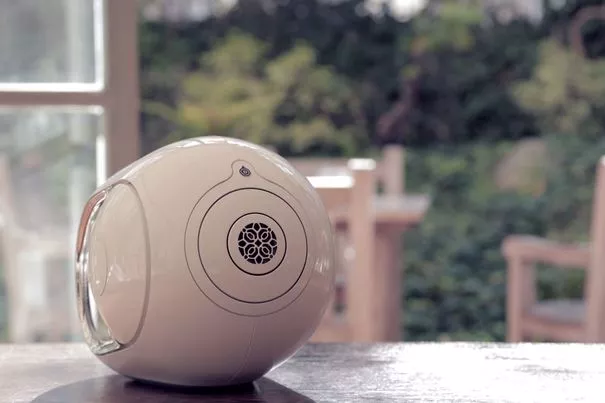
The Phantom is about setting up, getting started and having fun IN LESS THAN TEN MINUTES.
Immediately audible with the Phantom is the incredibly wide sound range. It delivers the extremely deep bass that was previously thought impossible from a speaker of this size. If you listen to the Koto Drummers about the Phantom, you will be astonished at the power and dynamics of the small loudspeakers. It is impressive what Devialet created with a lot of technical esprit.
The Phantom constantly monitors the playback. When the loudspeaker chassis reach their load limits, the sensors detect this, limit the deflections and slow down the energy supply. This ensures that the phantom never sounds unpleasantly distorted.
The power limit is set intelligently and the bass range is reduced when the volume reaches the limit. At low volumes, it then reproduces the entire bandwidth down to the lower registers, while at higher volumes the low bass is reduced. This is not least very pleasant for the neighbors.
In the mid and high-frequency range, the Phantom is surgically precise and is emphatic in its approach. No matter if Midnight Sugar of the Tsuyoshi Yamamoto piano trio is about impulsive dynamics in the discant or Sophie Hunger impressively brings us closer to a piece of life experience (in my testing), the Devialet Silver Phantom does not hide and always creates authenticity. It certainly does not belong to the flatterers of sound, but rather to the somewhat offensive and dynamic sounding loudspeakers.
The analytics are excellent. Jean Michel Jarre and Vangelis would certainly be delighted to hear their ethereal synthesizer sounds through the crisp and impulsive Phantom. But the nuance of a harpsichord is as finely fan out as the timbres of wind instruments and clarinet. One of his strengths is certainly also a stable spatial reproduction, which is more symphonic but actually beneficial for any kind of music. It is beautiful how it fans out complex passages, thus revealing the tonal view into the depths.
Of course, there are even more subtle and beautiful sounding loudspeakers, but they often require the usual high-end audio gimmicks like choosing the right amplifier and cable until the right playback chain is found.
The Phantom is about setting up, getting started, and having fun in just five minutes. Without having to worry too much about integration into the living environment. You can forget the whole nonsensical cable magic. Welcome to the new, slim audio world.
Devialet may not have revolutionized music reproduction, but with the Phantom, it has redefined the modern loudspeaker. The innumerable innovative solutions lead to a new type of loudspeaker.
The Phantom does not and cannot replace a full-grown high-end audio speaker. Real physical membrane surface, which works with small deflections on a stately housing volume, cannot be topped by even such an intelligent electronic control.
But who wants to place such titans of loudspeaker construction in the living room? Small loudspeakers with broadband sound in the bass range are only available pimped with digital signal processors and intelligent algorithms.
For example. Should you replace the speakers of a Smart TV or an older “dumb” TV of still 1080p for your living room? The answer is no. Those speakers can be sufficient for a living room. You can also detach them in many cases and place them in a different layout as you wish.
The Phantom shows impressively what is possible. It is more than just a loudspeaker, it is the perfect play partner for modern players from the network, be it via one of the current music services or the personal music archive. As a design object, it would also look good in the backdrop of a Luke Skywalker movie.
Sound Quality Of The Devialet Silver Phantom
If you turn it up properly, the extreme excursion of the side woofer cones may seem strained.
In terms of sound, however, the Phantom always demonstrates calmness and sovereignty: the silver hemispheres pump even ultra-deep basses from 16 Hertz into the room, which perceptibly penetrates to the diaphragm, powerfully and cleanly.
The bass blends harmoniously into the balanced overall sound, which breaks down musical pieces into their individual parts with impressive precision and presence, especially in the mids and lows. The high-frequency resolution underlines the finesse of the Phantom’s sound, even if the treble could take a touch more brilliance. However, a slight treble boost cannot (yet) be set due to a missing equalizer.
If you turn it up towards the stop, the otherwise so tight and sovereign bass reproduction appears somewhat less precise and cooler. However, this refers to volume levels that can confidently be regarded as acoustic terror. In the test, the Silver Phantom reached an almost painful 103 decibels. As rich as the Phantom may sound: Perhaps this is exactly why they tempt you to listen more analytically than to enjoy the relaxed pleasure of a well-woven carpet of sound.
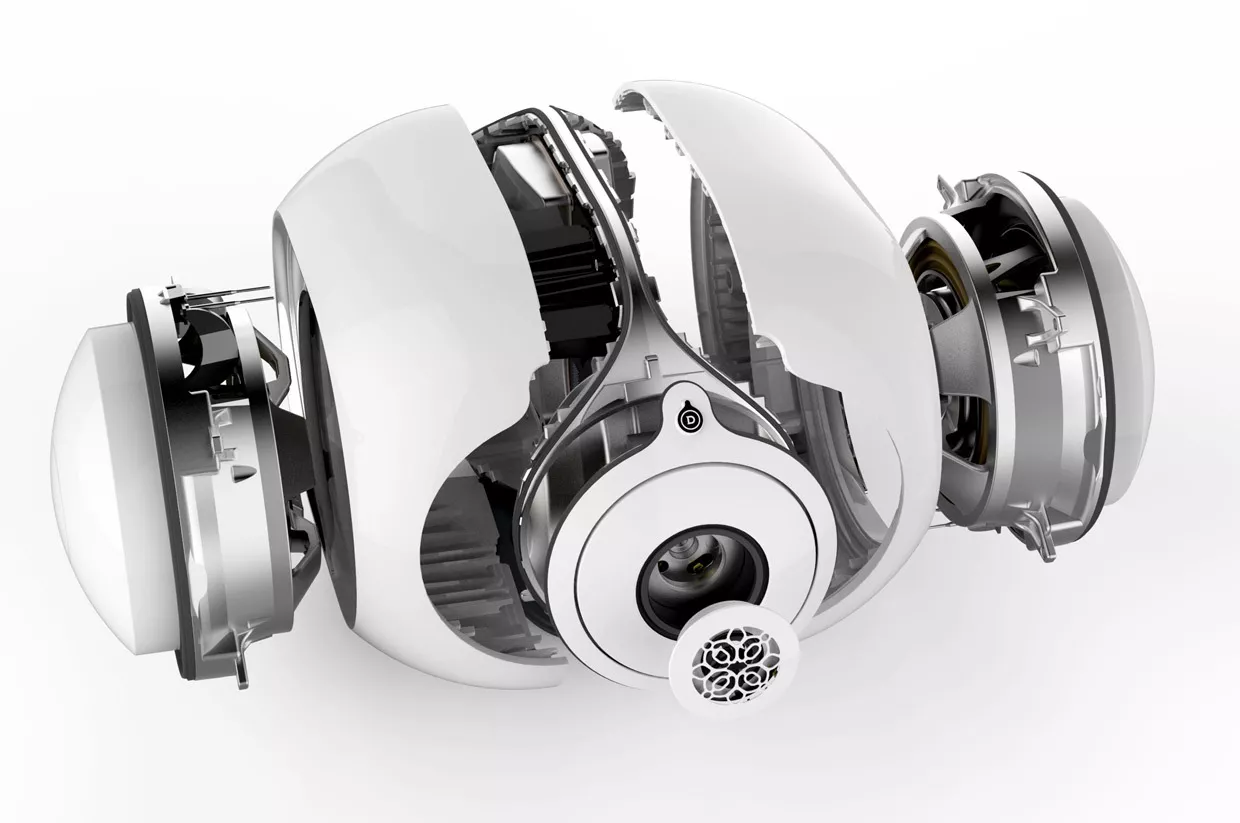
The exploded view – here of the smaller Silver model – gives an insight into the immense engineering achievements of the French. Great art in the smallest of spaces. he exploded view shows the extremely complex construction of the three-way loudspeaker. Inside there is also the reception technology for music playback via WLAN and Bluetooth.
Devialet Silver Phantom Specifications
GENERAL
-
Bluetooth ProfilesAdvanced Audio Distribution Profile (A2DP), Audio/Video Remote Control Profile (AVRCP)
-
ManufacturerDevialet
SPEAKER SYSTEM
-
Crossover Channel Qty3-way
-
Max (RMS) Output Power3000 Watt
-
Frequency Response16 – 25000 Hz
-
Output Level (SPL)105 dB
-
Output FeaturesHeart Bass Implosion (HBI)
-
Audio Amplifierintegrated
-
Connectivity Technologywired, wireless
-
Sound EffectsActive Cospherical Engine (ACE)
-
Built-in DecodersSBC decoder
AUDIO SYSTEM
-
Audio FormatsAAC, AIFF, Apple Lossless, FLAC, HE-AAC, MP3, OGG, Ogg Vorbis, WAV, WMA, apt-X
-
Typespeaker
POWER DEVICE
-
Nominal VoltageAC 120/230 V
-
Frequency Required50/60 Hz
-
Power SourceAC power adapter
NETWORK & INTERNET MULTIMEDIA
-
Connectivity InterfacesBluetooth, IEEE 802.11a/b/g/n, IEEE 802.3 (Ethernet), IEEE 802.3u (Fast Ethernet), IEEE 802.3z (Gigabit Ethernet)
MISCELLANEOUS
-
ColorRAL 9016, sand-blasted stainless steel, silver, white
-
Color Categorysilver, white
-
Body MaterialABS plastic, glass-filled polycarbonate
-
Bluetooth ProfilesAdvanced Audio Distribution Profile (A2DP), Audio/Video Remote Control Profile (AVRCP)
SPEAKER SYSTEM DETAILS
-
Speaker TypeBluetooth
DRIVER DETAILS (1ST SPEAKER)
-
Speaker Typespeaker
-
Driver Typemid-range driver, tweeter driver, woofer driver
-
Driver Qty1, 2
-
Driver Materialaluminum
CONNECTIONS
-
TypeLAN, digital audio input (optical)
-
Connector TypeRJ-45, TOSLINK
DIMENSIONS & WEIGHT
-
Width10 in
-
Depth13.5 in
-
Height10 in
-
Weight23.15 lbs
Conclusions For Our Devialet Silver Phantom Review
Viewed from the front, the loudspeaker looks like a bowling ball, from which a transducer is directed to the front, which reproduces the mid-high range. Two further bass converters are located on the side and play on a comparatively tiny volume.
Anything that happens before that will be done by an armada of electronics. Up to 3000 watts of peak power can be read impressively in the brochure but should neither be achievable nor demanded nor necessary in a normal living room.
Apropos living rooms: With the support of the 300 dollars network center, which is called Dialog, the Phantom, which can be controlled via Bluetooth, WLAN or a classic optical connection, accesses almost all relevant music sources: Smartphone, Tablet, PC, Apple Music, Web Radio, Spotify, Deezer, TV, Airplay, Netflix, CD Player, NAS – to name but a few.
Two Silver Phantoms then also become a stereo couple, and if you have too much money or rooms, you can distribute another 22 Phantoms arbitrarily in the seat of power and interconnect them. You could also add friends to the list, with whom you can create playlists using the Spark app.
Anyone who maliciously suspected pure design behind the Devialets must soon admit defeat: Of basses that are controlled via DSP, simultaneously round, warm and yet controlled, as if there were no stopping. What the Silver Phantom flares on a surface of 25 by 35 centimeters at a height of only 25 centimeters are more than impressive. Impressive yes, excessive no.
Because in combination with the very tidy midrange and pointed treble, the Devialet clearly moved from pure sound reinforcement to sophisticated hi-fi. Already one filled the room to such an extent that we envy all those who can afford two.
With its unit price, the Silver Phantom certainly can’t get a price tip. Its sound, its design and the consistency of its implementation, however, put it on the wish list of all those who appreciate its exceptional quality.
Operating it without instructions is not so easy. On the back above the conspicuous cable is a button to switch on. First press it once, then three times in a row to make the loudspeaker addressable. The simplest connection is via Bluetooth. The “Spark” app, with the help of which the phantom is integrated into the home network, makes things a little more complex. Since the app can also stream services like Tidal, Deezer or Qobuz, you only have to register and can play music directly from the app.
But unfortunately, this does not work as long as you do not buy another device. Devialet allows the integration of streaming services only with the help of the “Dialog” for 300 Euro. This is a station to be connected to the router, which manages these services and, if necessary, integrates another Phantom, that can be the Gold model, so that both become a stereo pair.
Devialet’s Phantom is therefore not only an active loudspeaker but can also be expanded into a multi-room system. There are plenty of them now, especially market leader Sonos. In order to differentiate itself from those products, Devialet has taken the high-end path. This means the highest quality technology, but also high prices. A Phantom equipped with 3000 Watt costs almost 2000 dollars.
But the egg-shaped thing with the shiny white plastic surprises a second time when you make it sound. As soon as volume and bass content increase, the two round silver elements jump out of the cabinet and back again parallel to the beat. It is an aluminum bass diaphragm that jumps left and right here.
Now it gradually becomes clear why the 10.5-kilogram Phantom must be such a heavyweight. The chassis suspension is so filigree and the sound pressure inside the closed housing so high that any vibration could upset the diaphragm. Put your hand on the case and you will not feel any movement. The remaining frequencies are handled by a midrange and tweeter, which are arranged coaxially on the front. The dome is behind a decorated grille, around it the midrange driver works according to a similar principle as the woofer. The arrangement of the three drivers essentially corresponds to the principle of a point source.
The three-way system is driven by an amplifier technology that is typical for Devialet. The French company has made a name for itself in the high-end scene with its amplifiers, whose approach is a combination of Class A and Class D switching elements.
The developers try quite tricky to combine the tonal advantages of Class-A technology with the efficiency of Class D switching amplifiers. What is immediately noticeable on first hearing are the performance reserves of the system. Loud is no problem for the Phantom, but rather for the listener when the volume is pushed to the limit because you are the first to leave the room before the speaker reaches its limits.
So the Phantom can make loud sounds without distortion, that is no question. Is it very good at it? Honestly, no.
If you want to make it easy for it, you feed him a hip-hop song. Then he can play out the low-frequency response, which he supposedly can reproduce up to 16 Hertz, with power. Even techno is rattling a lot. If the listener now pulls up a level by selecting more complex rock and pop numbers, the first doubts come. Voices, both male and female, usually sound very clear and pleasant, but leave their intended place and always step a few meters too far in front of the rest of the band to push them into the background.
Uncertainty is spreading on stage. Guitars sometimes fall down in the back or lose their contour, bass runs fall silent, nobody really knows where to go. The Phantom sometimes does not keep the band together with their instruments. Then it falls apart. And sometimes there is such a crowd as if the musicians were sitting confined in the case. When the phantom sorts the instruments in its own way, it sounds unique and takes getting used to it. Now one could still claim that it has occasional peaks in the highs and sounds slightly tinny. Let’s not do this.
All this can be improved with a second phantom, and then both can be defined as a stereo pair through dialogue. Then the sound rises significantly by one level higher, but so does the price. This is then around 4300 dollars. That’s a lot of money for a few active boxes with a streaming connection.
Then you should prefer speakers like the Nupro A-300 from Nubert from the HiFi range. They cost 1050 dollars a pair.
Expensive? No – even a single Phantom is worth its price, measured by its sound. The size of a sound system can be the deciding factor when buying a Phantom, and that’s exactly where the Phantom is a revolution: it plays in a completely different league than the size of the system suggests. It is the perfect speaker for those who have a serious interest in hi-fi sound close to perfection, but no interest in speaker towers and amplifiers.
Further Readings
We have some other interesting articles for you to read, we have selected our top articles below, and tried to keep this list short.
We have a technical vademecum where we discuss industry terminology and how it can be useful for you. Selected examples are the definition of PCM audio, then comes the comparison between PCM and Bitstream, the comparison between DTS Neo 2.5 and Dolby Digital, and the process to match amplifiers to speakers.
Also, we have reviewed some interesting DAC: The Elgar Plus from dCS, and the Schiit stack. where the Modi 3 behaves as an entry-level DAC.
In our reviews of AV receivers, we can recommend you to read some of our favorites, the ones that we liked the most, and trying to make the list short, we have the Denon AVR-X2500H, the Onkyo TX-NR686. We also have reviewed completely the Denon 8K receivers where we have studied the 8K Denon AVR-X2700H, the Denon AVC-X6700H, the AVC-X4700H, and the AVC-X3700H.
If you are into amplifiers, my favorite is the McIntosh MA9000, and that is why I would like to recommend you to read that review. My second favorite amplifier is the Mark Levinson 5805.
Regarding speakers, we have reviewed tiny bookshelf-speaker devices to large towers. My favorites were: the Devialet Gold, the Devialet Silver, the ProAc Response DT8, the Bowers and Wilkins 805 D3,
We do not review many headphones, but if you want a Sennheiser headphone for less than 100 dollars, we have this Sennheiser HD595 review.
We have some TV and monitor reviews and here we recommend the Samsung NU8000 (for gamers!) and my favorite is the review of the classical Pioneer Kuro.
Our home theater aficionados want to know everything about video definitions and configurations. So we studied 720p, how to scale it to 1080p the right way, and compared 1080p with 1440p and demonstrated why 1440p is not always better. Likewise, we had the urge to compare 1440k with 4K and try to find out how much are we gaining with the change.

I am Bob. I work as an audio engineer and audio technician. I work in mastering and arranging bridges in existing songs and the arrangement and orchestration of the chorus. In Planet HiFi I test gear for a couple of days and write a review. I also write about AV topics, amplifiers, speakers, and headphones.

